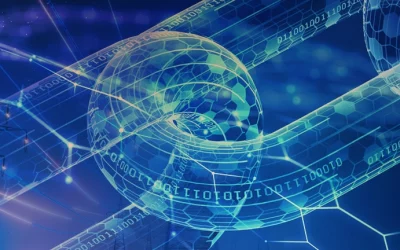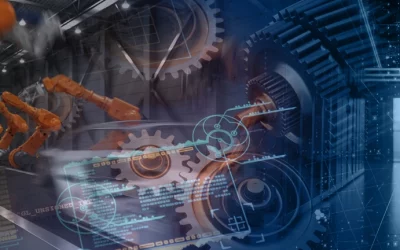Looking ahead to 2023 – digital trends, challenges,
and opportunities
Two certainties for 2023: the world will continue to spin on its axis at approximately 1,000mph, and the pace of technology advancement will remain unstoppable.
As we look back at 2022, and the political and economic uncertainties, it is easy to miss the disruptive innovation and positive progress made in the emergence of our increasingly connected, more sustainable, digital society.
Whilst we must remain cognisant of the challenges 2023 will bring, the digital landscape is far from bleak, and for those organisations keen to take advantage of the profound shifts we are witnessing and willing to work with their technology partners to act on them, 2023 has the potential to be a year rich in innovation.
Let’s consider the five trends that we anticipate will be key to this…
A new, more environmentally sustainable model for digital transformation emerges
The monetary cost and environmental impact of our nation’s power consumption is a shared concern for us as both individuals and organisations. A growing social conscience and evolving Government legislation mean that most organisations are now firmly committed to the pursuit of an ESG (Environmental, Social and Governance) strategy. For those suppliers delivering services into the public sector, they are already expected to display evidence of their commitment to ESG and robust green credentials. This trend will gain momentum as the public increasingly expect the services they consume to have minimal impact on the environment.
Simultaneously, the technology platforms and applications essential to operating an efficient, reliable, and competitive business continue to scale up, with access to always-on, high-performance compute and connectivity a critical requirement for disparate working models, and – as always – physical and digital security an absolute imperative.
To achieve and maintain compliance with ESG standards and legislation, organisations will need to invest in technology that will allow them to remain disruptive, progressive, and efficient in a challenging economy. As a longstanding supporter of organisations’ ESG agendas, we predict more organisations across all sectors will be looking to partially or fully migrate both new and existing infrastructure to best-in-class data centre facilities that offer the required standards of efficiency, sustainability, and security.
Cyber security evolves, ready to meet the challenges of a fully connected society
With numerous unprecedented shifts in the geopolitical landscape throughout 2022 alone, an evolving range of security threats must be given serious consideration, with global bad actors targeting everything from citizens’ private data to critical national infrastructure. In the UK alone, we saw several instances of this throughout 2022, including August’s cyber-attack on South Staffordshire PLC, the parent company of South Staffs Water and Cambridge Water, which resulted in numerous customers’ data being compromised, a data breach taking down Royal Mail’s website in November, due to an incident that allowed users to access other customers’ data, and the North-East London NHS Foundation Trust’s financial systems experiencing a ransomware attack in August.
The situation is compounded by our increasingly connected society, the convergence of information technology and operational technology, and the growth of the IoT. Taking all this into account, most organisations must contend with an expanded attack surface, which makes developing a robust cyber security ecosystem considerably more complex and – without the right guidance – costly.
For this reason, we anticipate the evolution of cyber security ecosystems to continue accelerating in the year ahead, with organisations and their IT and OT technology partners working to streamline the process of implementing patches and security updates in response to the latest threat intelligence, whilst ensuring they have access to security experts on a 24/7 basis to proactively respond to any potential incidents. Critically, the concept of cyber security will expand to encompass a new breed of disaster recovery solutions that will ensure critical infrastructure can be restored in days, rather than weeks, in the event of a successful attack, and any vulnerabilities identified and resolved.
Managing data at the edge, with the next generation of hybrid Cloud
Hybrid Cloud solutions are increasingly establishing themselves as the ideal way for organisations to either phase out legacy infrastructure as it enters end of life, or ring fence and continue to support critical applications and data that must be hosted on-site for security or compliance purposes, whilst benefiting from the flexibility, scalability, and control offered by migrating less critical workloads to Public Cloud solutions. There has already been a rich vein of innovation in this area, with organisations working closely with specialist technology providers like Vysiion to create bespoke hybrid solutions that meet the most complex requirements in terms of functionality and compliance.
Based on conversations we have had with organisations across a number of challenging sectors regarding their evolving Cloud transformation goals, we anticipate the biggest Hybrid Cloud development throughout 2023 will be the extension of these solutions to the edge, allowing Private Clouds to encompass data centres, edge locations, industrial environments, and offices. There are several ways of accomplishing this, but essentially, the concept involves building a Private Cloud within a dedicated platform or an edge server to segregate critical data, while maintaining the functionality of any public Cloud solutions already utilised – potentially the best of both worlds.
Vysiion – working with leading Cloud providers such as Amazon, Microsoft, and Google – have already been developing new solutions in this regard, building on existing stacks. These offer a huge range of potential opportunities, provided they are intelligently implemented and integrated into wider digital transformation strategies, which means organisations with highly specific compliance and data protection obligations, and those working with converged IT/OT environments should seriously consider this new model.
Monitoring, support, and resolution go ‘always on’
The public expect the services they utilise – whether it is as consumers or citizens – to be available 24/7, 365 days a year. To achieve this, it’s not enough to develop ‘always on’ systems; the right experts must be always available, to ensure the downtime from any incidents is kept to the absolute minimum and that the integrity of critical data is maintained. As a result, monitoring and support services must be aligned with the same 24/7 model as the systems they maintain.
While this is simple in theory, putting it into practice has become much more complex. The increasing number of attack vectors that must be secured – as discussed above – means the patching that effective security ecosystems depend on is frequently too complex and time-consuming a task for internal teams to manage, particularly when on-site support is required in remote or challenging environments.
To ease the burden on internal teams, outsourcing 24/7 support and monitoring functions is likely to become the norm for organisations at all levels in the months ahead, as will the convergence of desk support and field maintenance functions. Vysiion continues to develop its support service in this regard, freeing organisations to focus their internal teams on other business-critical functions, confident that maintenance and patching routines on key It and OT infrastructure are completed in a timely and effective manner, and any downtime kept to the absolute minimum.
The hidden potential of unstructured data reveals itself
It can be argued that many organisations’ data is their most precious resource, offering numerous opportunities to improve operational efficiency, reduce costs, and deliver exceptional outcomes. From manufacturing to CNI, defence, transport, and healthcare, the growing volumes of unstructured data that are generated onsite each day can potentially be turned into a powerful tool for growth, innovation, and service enhancement.
The question then, is how to best put this into practice.
As more and more organisations explore AI, big data, and machine learning initiatives, and the adoption of Trusted Research Environments (TREs) increases, technology infrastructure must evolve with such projects, and the platforms they depend on, in mind. This will encompass all the areas we have already looked at in this blog, from Cloud and connectivity to cyber security and disaster recovery, but the potential is enormous. As a result, the growing number of organisations who are exploring how to unleash the full potential of their unstructured data would be well-advised to consult a technology partner with proven experience in the successful execution of similar projects. Throughout 2023, such partnerships are likely to power a whole new model for how we utilise our data.
Wishing you a successful and enjoyable 2023!
If you would like to explore any of the trends discussed in this blog in greater depth, do not hesitate to contact us. In the meantime, we wish you a Happy New Year and look forward to working together in the months ahead!
A recent high-profile breach has driven home the need for a new model of OT security
Considering the impact of the recent Volt Typhoon incident and what can be done to optimise the security and resilience of CNI
Secure by design’ must become the new norm for mission-critical infrastructure
Cyber security is a priority as threats grow in frequency, scale, and sophistication. For Operators of Essential Services (OESs), IT/OT convergence and complex compliance demands require a more integrated, ‘secure by design’ approach.
A new model of high-resilience data hosting for tomorrow’s interconnected manufacturing
With manufacturing now officially part of the UK’s CNI sector, what steps can organisations take to bring their operations in line with CNI rigorous standards of security and resilience?
Contact us...
Schedule a Consultation
Contact Vysiion today to discuss your CNI technology needs.



